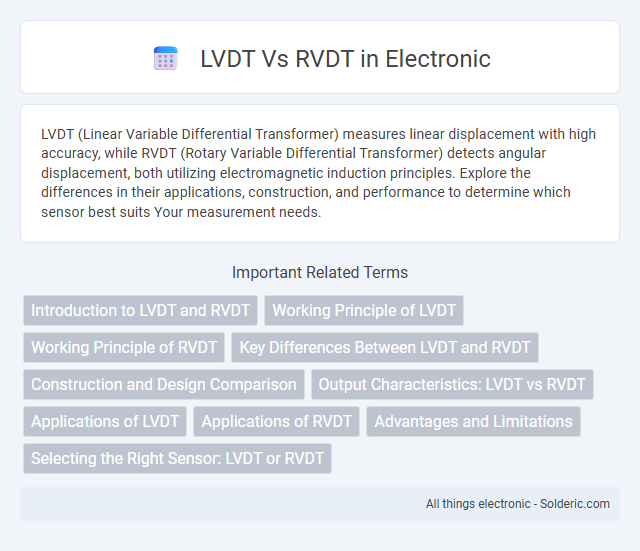LVDT (Linear Variable Differential Transformer) measures linear displacement with high accuracy, while RVDT (Rotary Variable Differential Transformer) detects angular displacement, both utilizing electromagnetic induction principles. Explore the differences in their applications, construction, and performance to determine which sensor best suits Your measurement needs.
Comparison Table
| Feature | LVDT (Linear Variable Differential Transformer) | RVDT (Rotary Variable Differential Transformer) |
|---|---|---|
| Measurement Type | Linear displacement | Angular displacement (rotary position) |
| Output Signal | AC voltage proportional to linear position | AC voltage proportional to angular position |
| Sensing Element | Sliding core inside coils | Rotating core inside coils |
| Range | Typically +-5 mm to +-50 mm | Typically +-30deg to +-45deg rotation |
| Accuracy | High accuracy, repeatability & stability | High accuracy, repeatability & stability |
| Applications | Position sensing in automation, aerospace, robotics | Angular position sensing in servo mechanisms, aerospace |
| Output Type | Analog signal (differential voltage) | Analog signal (differential voltage) |
| Environmental Durability | Robust, resistant to dirt, dust, and shock | Robust, used in harsh environments |
Introduction to LVDT and RVDT
LVDT (Linear Variable Differential Transformer) and RVDT (Rotary Variable Differential Transformer) are precision sensors used to measure linear and angular displacement respectively. LVDTs convert linear motion into electrical signals by detecting core position changes within a cylindrical coil, while RVDTs measure rotational position through the angular displacement of a rotor affecting transformer windings. Both devices offer high accuracy, frictionless operation, and are widely utilized in aerospace, industrial automation, and robotics for position sensing.
Working Principle of LVDT
The working principle of an LVDT (Linear Variable Differential Transformer) relies on electromagnetic induction to convert linear displacement into an electrical signal. It consists of a primary coil energized by an AC source and two secondary coils wound in series opposition; the movable ferromagnetic core alters the magnetic flux coupling between these coils. The differential voltage induced in the secondary coils is proportional to the core's position, enabling precise measurement of linear movement.
Working Principle of RVDT
RVDT (Rotary Variable Differential Transformer) operates on the transformer principle, utilizing a primary coil energized with an AC voltage to induce voltages in two secondary coils positioned symmetrically around the primary. As the rotor shaft rotates, it changes the magnetic coupling between the primary and secondary coils, causing a differential output voltage proportional to the angular displacement. This output voltage is used to accurately measure rotational positions, distinguishing RVDT from LVDT, which measures linear displacement.
Key Differences Between LVDT and RVDT
LVDT (Linear Variable Differential Transformer) measures linear displacement, while RVDT (Rotary Variable Differential Transformer) measures angular displacement. LVDTs provide high accuracy and frictionless contact for linear position sensing, whereas RVDTs are designed for rotational position detection with a similar transformer-based principle. The core difference lies in their mechanical design and output signal corresponding to linear or rotational movement.
Construction and Design Comparison
LVDTs (Linear Variable Differential Transformers) consist of a primary coil centered between two secondary coils with a movable ferromagnetic core that produces a linear displacement output, while RVDTs (Rotary Variable Differential Transformers) use a cylindrical rotor positioned between the primary and secondary windings to measure angular displacement. LVDT construction enables precise linear position sensing with high sensitivity and frictionless operation due to the non-contact core movement. RVDT design incorporates a rotary shaft and bearings for angular rotation measurement, offering robustness in applications requiring rotary position feedback.
Output Characteristics: LVDT vs RVDT
LVDT (Linear Variable Differential Transformer) offers a linear output voltage proportional to the linear displacement, providing high accuracy and sensitivity for precise position sensing. RVDT (Rotary Variable Differential Transformer) delivers an output voltage proportional to angular displacement, optimized for rotary motion measurement with a linear relationship over a limited angular range. Both sensors utilize differential transformer principles, but LVDT is preferred for linear displacement due to its frictionless core and infinite resolution, whereas RVDT excels in angular position with robust output linearity within its specified rotational limits.
Applications of LVDT
LVDTs (Linear Variable Differential Transformers) are widely used in precise position sensing applications such as aerospace, industrial automation, and robotics due to their high accuracy and reliability in measuring linear displacement. They excel in environments requiring contactless measurement and high durability, including hydraulic cylinder position feedback and vibration monitoring. Your system benefits from LVDTs' strong immunity to environmental conditions like dust, moisture, and temperature variations.
Applications of RVDT
RVDTs (Rotary Variable Differential Transformers) are widely used in aerospace for precise angular position sensing in flight control systems and autopilots. They are essential in industrial automation for monitoring rotary actuators and valve positions, where accuracy and robustness under harsh conditions are critical. Additionally, RVDTs find applications in robotics and defense systems, offering reliable feedback for rotary motion control and weaponry stabilization.
Advantages and Limitations
LVDTs offer high accuracy, frictionless operation, and excellent repeatability, making them ideal for linear position sensing in demanding industrial applications. RVDTs provide robust angular position measurements with low power consumption and reliable performance under harsh environmental conditions. Your choice depends on whether precise linear displacement or angular rotation data is required, balancing cost, sensitivity, and environmental tolerance.
Selecting the Right Sensor: LVDT or RVDT
Selecting the right sensor between LVDT and RVDT depends on the application's measurement requirements: LVDTs excel in linear displacement detection with high accuracy and frictionless operation, ideal for precision position feedback. RVDTs are preferred for angular displacement measurement, offering robust performance in rotary motion sensing with high resolution and reliability. Consider factors like motion type, environmental conditions, and required sensitivity to determine whether a linear variable differential transformer (LVDT) or rotary variable differential transformer (RVDT) best suits the sensor application.
LVDT vs RVDT Infographic

 solderic.com
solderic.com